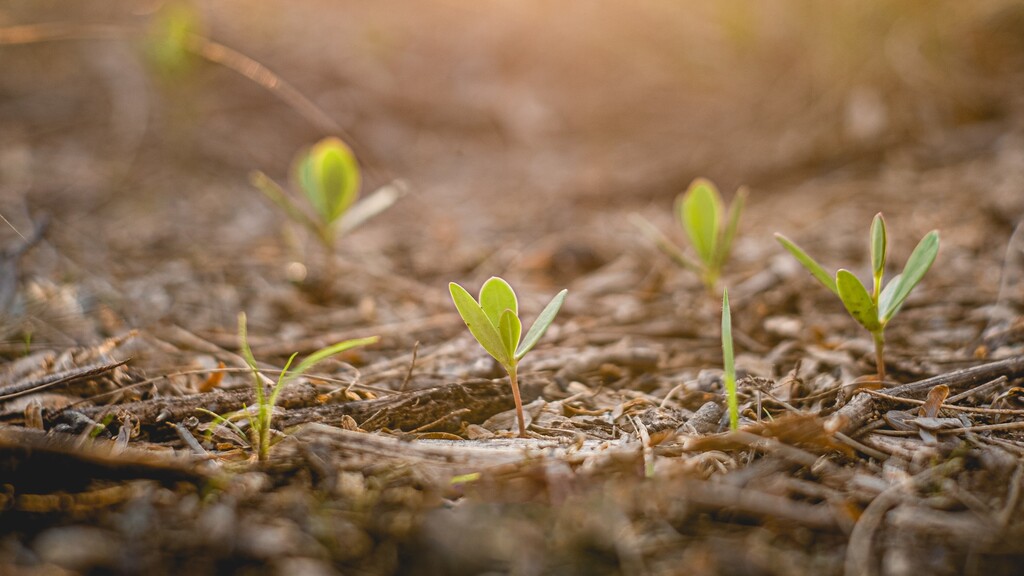

Will man verstehen, wie Treibhausgase aus der Atmosphäre gezogen werden können, muss man unweigerlich den Blick auf die natürlichen Kohlenstoffsenken der Biosphäre lenken.
Kohlenstoffsenken werden in der Geowissenschaft auch als natürliche CO2-Reservoirs bezeichnet. Diese sind Bestandteil des natürlichen Kohlenstoffkreislaufs und beeinflussen das Erdklima seit Urzeiten. Innerhalb des Kohlenstoffkreislaufes wird zwischen Kohlenstoffsenken und Kohlenstoffquellen unterschieden. Menschen nutzen die Quellen in Form von fossilen Brennstoffen wie Erdöl, Erdgas oder Kohle. Diese waren und sind leider immer noch der Motor des menschlichen industriellen Aufstiegs. Den Senken hingegen, beispielsweise intakte Ökosysteme wie Moore oder Wälder, wird im Kampf gegen die globale Erderwärmung und Eingrenzen des Klimawandels bedeutsames Potenzial zugesprochen. Ist wegen des Klimawandels ihre natürliche Balance gestört, kippen ihre Systeme ins Ungleichgewicht und die Ökosysteme und ihre CO2-Speicherfähigkeit sind verloren.
Terrestrische Ökosysteme, oder Land-Ökosysteme, spielen im Kampf gegen den Klimawandel eine wichtige Rolle. 30 % der menschengemachten CO2-Emissionen können durch sie aufgenommen werden. Der Vegetation kommt hier durch ihre Fotosyntheseleistung eine Schlüsselrolle zu: Wälder nehmen für ihren Wachstum Kohlenstoffdioxid direkt aus der Luft auf und speichern Kohlenstoff in der Biomasse, im Totholz und im Mineralboden.
Es gibt vielfältige Forschungsergebnisse zur Kohlenstoffbindung von Bäumen, doch tatsächlich sind allgemeine Aussagen aufgrund der zu differenzierenden Strukturen und Eigenschaften von Wäldern oft nicht möglich. Wie viel CO2 ein Baum innerhalb seiner Lebenszeit aufnehmen kann, ist von vielen Faktoren abhängig, z. B. von der Baumart, dem Alter des Baumes, dessen Holzdichte, Blattmasse, Wurzelmasse und auch seiner Zuwachsrate. Aber vor allem auch Standortfaktoren haben einen Einfluss auf seine Leistungsfähigkeit, CO2 aus der Luft oder dem Boden zu binden: Dazu gehören etwa die Bodenqualität, das Klima, die Wasserversorgung und das Einwirken durch den Menschen ganz direkt.
Naturefund hat auf Basis der Angaben des United Nation Framework for Climate Change Convention (UNFCCC) und mehr als 70 eigens ausgewerteten Studien einen Durchschnittswert von 500 kg CO2 berechnet, die ein Baum während seiner Lebensdauer speichert.
Neben Sümpfen, Auen und Feuchtwiesen gehören auch Moore zur Kategorie der Feuchtgebiete. Obwohl Moore nur ca. 3 % der Landoberflächen ausmachen, sind diese dennoch bedeutsame Kohlenstoffsenken. Weltweit speichern Moore 400–500 Gigatonnen Kohlenstoff. Dies wiederum sind 26–44 % des insgesamt im Boden gebundenen Kohlenstoffs. Moore werden als „Nieren der Landschaft“ bezeichnet, da sie neben der Aufnahme von CO2 zudem noch Grundwasser filtern, wie Schwämme fungieren und so einen wichtigen Teil des Hochwasserschutzes bilden. Moore wachsen kontinuierlich und das bereits seit der letzten Eiszeit vor 12.000 Jahren.
Der Kohlenstoff sitzt im Torf: Moore sind einzigartige Ökosysteme für unzählig viele Arten. Der Bildung von Torf kommt hier eine Schlüsselrolle zu: Wenn Pflanzen absterben, zersetzen diese sich aufgrund der nassen Bedingungen nicht vollständig. Als Ergebnis entwickelt sich Torf, welcher Kohlenstoff speichert. Dramatische Folgen hat daher der Torfabbau durch menschliche Hand: Moore werden trockengelegt und das Torf entwendet, die natürlichen Speicher zerstört und das klimaschädliche CO2 gelangt neben anderen Treibhausgasen in die Atmosphäre. Heute befinden sich nur noch ca. 5 % der in Deutschland vorkommenden Moore in einem natürlichen Zustand.
Wenn wir die Moore nicht schützen, entwickeln diese sich im schlimmsten Falle von einer Kohlenstoffsenke hin zu einer Quelle. Die Erderwärmung bedingt durch Bakterien und Mikroorganismen eine verstärkte Mineralisierung von organischen Materialien des Moorbodens. Ob die dadurch freigesetzten Treibhausgase dann in die Atmosphäre gelangen, hängt von der Höhe des Wasserspiegels ab.
Die effektivste Form Moore zu schützen, ist diese zu ausgewiesene Naturschutzzonen zu erklären. Die meist sehr aufwendigen Renaturierung-Prozesse zielen auf Wiedervernässung von trockengelegten Flächen. Bis heute konnte Naturefund bereits ca. 250.000 m2 Moor kaufen und dauerhaft für die Natur sichern. Aber der Schutz weiterer Flächen ist dringend notwendig.
Graslandschaften sind Oasen biologischer Artenvielfalt. Etwa 40 % der weltweiten Landfläche sind Grasländer – Mehr Fläche als Wälder mit 30 % einnehmen. Doch Graslandschaften werden in Klimaschutzfragen oft ignoriert. Ihr Zustand wird derzeit als kritisch eingeschätzt, denn diese werden zu Dreivierteln landwirtschaftlich genutzt und werden als Folge dessen als „degradiert“ eingestuft. In speziellen Teilen der Erde liegt der Grad an Landverödung bei 60 % (Brasilien) und in Europa sogar bei 90 %. Übermäßiger Einsatz von Düngemitteln, Überweidung, Bodenerosion und ausgeräumte Monokultur-Steppen belasten das Grundwasser und führen zur Verarmung biologischer Vielfalt.
Die Kohlenstoffbindung in Graslandschaften und auch landwirtschaftlich genutzten Flächen bezieht sich sowohl auf die überirdische als auch unterirdische Biomasse. Den Böden kommt hier eine gesonderte Rolle zu. Überirdische Pflanzen geben das gebundene CO2 nach Absterben oder Ernte frei, während der Boden die konstantere Kohlenstoffsenke ist. Die erste Bodenzustandserhebung 2018 konnten aufzeigen, dass ca. 2,5 Milliarden Tonnen organischer Kohlenstoff in den ersten Metern unserer heimischen Äcker gespeichert ist. Zum Vergleich: Naturbelassenes Grünland speichert im Schnitt sogar doppelt so viel Kohlenstoff wie Ackerböden.
Der Humusanteil ist bedeutsam zur Aufnahme von CO2 in den Böden. Der Aufbau von 0,1 Prozent Humus pro Hektar entspricht etwa einer Bindung von drei bis sechs Tonnen CO2, abhängig von der Bodenart. Durchschnittlich befinden sich ganze 8 % Humus in Grünlandflächen und damit binden diese Flächen mehr Kohlenstoff als die Erde unter Wäldern. Der Gesunderhaltung unserer heimischen Böden kommt also bisher viel zu wenig Aufmerksamkeit zu.
Naturschutzprojekte sind ausdrücklich aufgerufen, den Humusgehalt der Böden zu fördern. Jedoch gibt es bisher keine konkrete Empfehlung diese auch durch sogenannte "Humuszertifikate", oder CO2 -Emissionszertifikate, zu unterstützen. Über 30 Organisationen und Personen aus Umwelt- und Klimaschutz haben sich in einem offenen Positionspapier 2021 gegen dieses Instrument zu Kompensationszwecken entschieden. Der stärkste Grund ist die nicht gegebene Permanenz der Bindung des Kohlenstoffs. Der Humusanteil im Boden weist für eine solche Zertifizierung eine zu starke natürliche und durch den Menschen bedingte Dynamik auf. Eine Zertifizierung als langfristiger Klimanutzen ist unter dem momentanen Konsens zu Forschungsständen also bisher nicht möglich.
Wenn Sie Kohlenstoffsenken schützen möchten, dann suchen Sie sich ein für Sie geeignetes Projekt heraus und schützen damit die Natur.